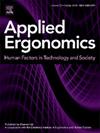士兵们会遇到健康问题,肌肉骨骼疼痛,装备和机动性受到军事防弹衣的干扰。
IF 3.4
2区 工程技术
Q2 ENGINEERING, INDUSTRIAL
引用次数: 0
摘要
本研究旨在比较澳大利亚男女士兵在穿着防弹衣时所经历的健康、肌肉骨骼疼痛和干扰问题,并量化人体测量特征对这些问题的影响程度。方法:77名男性和12名女性澳大利亚士兵完成了一份关于他们对防弹衣的看法的调查问卷,包括健康、肌肉骨骼疼痛、对其他设备的干扰和行动限制等问题。结果:女性在穿上防弹衣时遇到了不成比例的挑战,特别是长度和宽度过大,导致更大的肌肉骨骼疼痛、设备干扰和行动限制。男性还报告说,他们的防弹衣太长,在执行职业任务时限制了行动能力。前胸长度是最有力的防身衣相关问题的预测指标,它比胸宽或胸围更能影响移动性、舒适性和可接受性。结论:防弹衣的尺寸和设计的修改,特别是系统的长度,是必要的,以提高适合和职业表现。本文章由计算机程序翻译,如有差异,请以英文原文为准。
Soldiers experience fit issues, musculoskeletal pain, and equipment and mobility interference with military body armour
Introduction
This study aimed to compare fit, musculoskeletal pain and interference issues experienced by male and female Australian soldiers when wearing body armour, as well as quantify the extent to which anthropometric characteristics contribute to these issues.
Methods
77 male and 12 female Australian soldiers completed a questionnaire about their perception of body armour, including questions about fit, musculoskeletal pain, interference with other equipment and mobility restrictions.
Results
Females experienced disproportionate challenges with body armour fit, particularly excessive length and width, leading to greater musculoskeletal pain, equipment interference and mobility restrictions. Males also reported issues with body armour being too long and limiting mobility during occupational tasks. Front length was the strongest predictor of body armour-related issues, affecting mobility, comfort and acceptability more than chest breadth or circumference.
Conclusion
Body armour size and design modifications, particularly to system length, are necessary to improve fit and occupational performance.
求助全文
通过发布文献求助,成功后即可免费获取论文全文。
去求助
来源期刊

Applied Ergonomics
工程技术-工程:工业
CiteScore
7.50
自引率
9.40%
发文量
248
审稿时长
53 days
期刊介绍:
Applied Ergonomics is aimed at ergonomists and all those interested in applying ergonomics/human factors in the design, planning and management of technical and social systems at work or leisure. Readership is truly international with subscribers in over 50 countries. Professionals for whom Applied Ergonomics is of interest include: ergonomists, designers, industrial engineers, health and safety specialists, systems engineers, design engineers, organizational psychologists, occupational health specialists and human-computer interaction specialists.
 求助内容:
求助内容: 应助结果提醒方式:
应助结果提醒方式:


